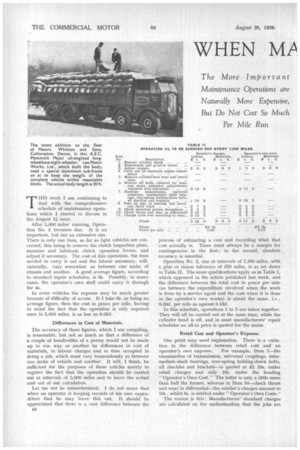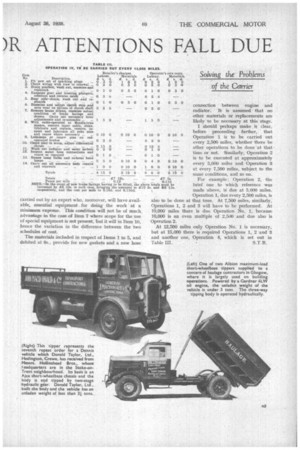WHEN MA a ATTENTIONS FALL DUE
Page 36

Page 37

If you've noticed an error in this article please click here to report it so we can fix it.
THIS week I am continuing to deal with the comprehensive schedule of maintenance operations which I started to discuss in the August 12 issue.
After 5,000 miles' running, Operation No. 2 becomes due. It is an important, but not an extensive one. There is only one item, so far as light vehicles are concerned, this being to remove the clutch inspection plate, examine and lubricate clutch operation levers, and adjust if necessary. The cost of this operation, the time needed to carry it out and the labour necessary, will, naturally, vary somewhat as between one make of chassis and another. A good average figure, according to standard repair schedules, is Os. Possibly, in many cases, the operator's own staff could carry it through for 4s.
In some vehicles the expense may be much greater because of difficulty of access. If I take 6s, as being an average figure, then the cost in pence per mile, having in mind the fact that the operation is only required once in 5,000 miles, is as low as 0.02d.
Totals
Differences in Cost of Materials.
The accuracy of these figures, which I am compiling, is reasonable, but not so much so that a difference of
a Couple of hundredths of a penny would not be made up in one way or another by differences in cost of materials, in labour charges, and in time occupied in doing a job, which must vary tremendously as between one make of vehicle and another. It will, I think, be sufficient for the purposes of these articles merely to
register the fact that the operation should be carried out at intervals of 5,000 miles and to leave the actual cost out of our calculation.
Let me not he misunderstood. I do not mean that when an operator is keeping records of his own expenditure that he may leave this out. It should be appreciated that there is a vast difference between the
02 process of estimating a cost and recording what that cost actually is. There must always be a margin for contingencies in the first; in the second, absolute accuracy is essential.
Operation No. 3, due at intervals of 7,500 miles, with a plus or minus tolerance of 250 miles, is as set down in Table II, The same qualifications apply as in Table I. which appeared in the article published last week, and the difference between the total cost in pence per mile (as between the expenditure involved when the work is done by a service agent and the cost when it is done in the operator's own works) is about the same, i.e., 0.20d. per mile as against 0.13d.
In this schedule, operations 1 to 5 are taken together. They will all be carried out at the same time, while the cylinder head is off, and in most manufacturers' repair schedules an all-in price is quoted for the series.
Retail Cost and Operator's Expense.
One point may need explanation. There is a variation in the difference between retail cost and an
operator's own expense. For example, Item 7—the examination of transmission, universal couplings, intermediate-shaft bearings, rear-spring holding-down bolts, all shackles and brackets—is quoted at £1 10s. under retail charges and only 18s. under the heading "Operator's Own Cost." The latter is only a little more than half the former, whereas in Item 1.0—check thrust and wear in differential—the retailer's charges amount to lOs., whilst 8s. is debited under "Operator's Own Costs."
The reason is this : Manufacturers' standard charges are calculated on the understanding that the jobs are carried out by an expert who, moreover, will have available, essential equipment for doing the work at a minimum expense. This condition will not be of much advantage in the case of Item 7 where scope for the use of special equipment is not present, but it will in Item 10, hence the variation in the difference between the two schedules of cost.
The materials included in respect of Items 1 to 5, and debited at 8s., provide for new gaskets and a new hose connection between engine and radiator. It is assumed that no other materials or replacements are likely to be necessary at this stage.
I should perhaps make it clear, before proceeding farther, that
0 Operation 1 is to be carried out
every 2,500 miles, whether there be other operations to be done at that time or not. Similarly, Operation 2 is to be executed at approximately every 5,000 miles and Operation 3 to the at every 7,500 miles, subject same conditions, and so on.
For example ; Operation 2, the brief one to which reference was made above, is due at 5,000 miles. Operation 1, due every 2,500 miles, is also to be done at that time. At 7,500 miles, Operations 1, 2 and 3 will have to be performed. At 10,000 miles there is due Operation No. 1, because 10,000 is an even multiple of 2,500 and due also is Operation 2.
At 12,500 miles only Operation No. 1 is necessary, but at 15,000 there is required Operations 1, 2 and 3 and another one, Operation 4, which is set out in Table III.




















































































